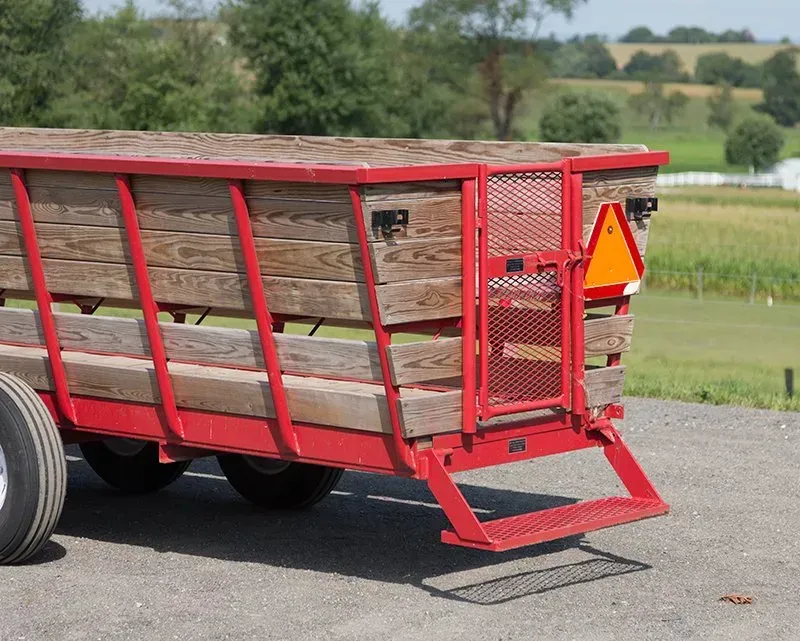CALL Us
Blog

Hayride Wagon Size & Weight Guide: Find Your Perfect Match
How to Choose the Right Size and Weight Capacity for Your Hayride Wagon
Picking the right hayride wagon might seem simple, but many factors impact how well it works for your needs. A wagon that's too small won't carry enough people or cargo, while one that's too large might be hard to tow or store.
The ideal hayride wagon size and capacity should match both your towing vehicle's capabilities and your intended use. Whether you're running a seasonal attraction, moving farm supplies, or hosting family events, getting this match right ensures safety and functionality.
Today, we'll walk through everything you need to know about hayride wagon sizing. From passenger counts to terrain challenges, we'll help you make a smart choice that serves your needs for years to come.
Understanding Hayride Wagon Basics
Before diving into sizes and weights, let's get familiar with the basics. Hayride wagons come in several types, each with different purposes:
Traditional hay wagons: Flat beds with railings, often used for recreational hayrides
Utility farm wagons: Heavy-duty designs focused on carrying supplies and equipment
Specialty hayride wagons: Custom-built models with bench seating and safety features
Quality hayride wagons share some key parts. Look for solid axles, a durable frame, and proper braking systems. These basics ensure your wagon handles well and lasts long, no matter what size you choose.
Determining the Right Size for Your Needs
When thinking about wagon size, start with these questions:
How many people will your wagon need to carry?
What types of items will you transport?
Where will you store the wagon when not in use?
For passenger capacity, a good rule is to allow 18-24 inches of bench space per adult. Children need slightly less. For a family hayride, a wagon around 8 feet long might work well. For commercial operations, wagons 16-20 feet long are more common.
Width matters too. Most hayride wagons range from 6-8 feet wide. Wider wagons offer more seating but may be harder to maneuver or store. Think about the paths your wagon will travel and any gates or doors it needs to pass through.
Weight Capacity: The Critical Factor
Weight capacity might be the most important spec to consider. To figure out how much capacity you need:
Estimate the maximum number of passengers (average adult weight × number of riders)
Add the weight of benches, decorations, and hay
Include a 20% safety margin for uneven loads
For example, a wagon carrying 20 adults (averaging 180 pounds each) plus 200 pounds of seating and decorations would need:
20 × 180 = 3,600 pounds
3,600 + 200 = 3,800 pounds
3,800 × 1.2 = 4,560 pounds capacity needed
Different terrains affect weight ratings too. Flat, smooth surfaces allow wagons to carry closer to their maximum capacity. For hilly or rough terrain, reduce your expected capacity by 30-40% to maintain safety margins.
How weight gets spread across your wagon matters as well. Even distribution prevents axle stress and improves handling. Make sure passengers or cargo spread out rather than clustering in one area.
Matching Your Wagon to Your Towing Vehicle
Your towing vehicle must be able to safely pull your fully loaded wagon. Most hayride wagons connect to tractors, trucks, or large UTVs.
Check your vehicle's tow rating before choosing a wagon. Remember that:
Small garden tractors typically handle up to 1,000 pounds
Mid-size farm tractors can pull 2,000-5,000 pounds
Large agricultural tractors can manage 5,000+ pounds
The wagon's tongue weight (downward force at the hitch) should be about 10-15% of the total loaded weight. Too little tongue weight makes the wagon unstable; too much strains your towing vehicle.
Customization Options for Your Wagon
Once you've settled on size and weight capacity, consider customization options:
Colors can make your wagon stand out or match your farm's look. Popular choices include traditional red, green, or natural wood finishes.
Entrance options affect how people get on and off. Options include:
Rear entry gates
Side entry with steps
Multiple entry points for faster loading
Additional features worth considering:
Hoop and tarp systems for weather protection
Cushioned seating for comfort
Safety rails at proper heights
Lights for evening operation
Each add-on affects the wagon's weight and capacity, so factor these into your calculations.
Maintenance Considerations Based on Size
Larger wagons need more storage space and maintenance. A 20-foot wagon requires a storage area at least 22 feet long to accommodate the tongue. Height clearance matters too if your wagon has permanent seating or rails.
Wheel and axle maintenance becomes more critical as wagon size increases. Larger wagons put more stress on these components. Regular greasing and inspection prevents problems and extends your wagon's life.
For durability, consider whether your wagon will be stored indoors or outdoors. Outdoor storage may require additional treatments or covers, especially for larger wagons with more exposed surface area.
Making Your Final Decision
When comparing wagons, weigh cost against value. A well-built wagon costs more upfront but lasts many seasons with less maintenance. For commercial operations, this value calculation is especially important.
Gap Hill Farm Wagons offers some of the best options on the market today. Their custom-built hayride wagons come in various sizes with weight capacities suitable for both family farms and commercial operations. Each wagon includes proper safety features and can be customized to your exact needs.
Ready for a Hayride Wagon That Perfectly Fits Your Needs?
Stop struggling with undersized or overbuilt equipment. Contact Gap Hill Farm Wagons today to discuss your specific requirements and get a custom quote on the perfect hayride wagon for your operation. Your ideal fall season starts with the right equipment!
Contact Information
Business Hours
Mon - Fri: 8:00 am -5:00 pm
Sat - Sun: Closed
© 2025 All Rights Reserved | Gap Hill Farm Wagons
